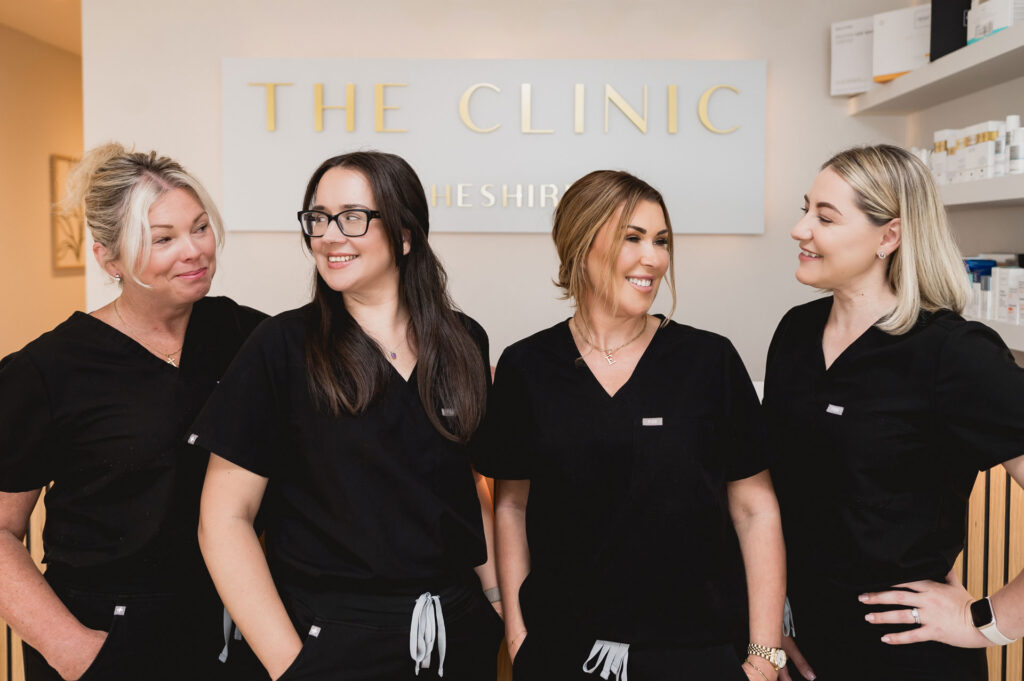
Aesthetic Treatments to Consider Before Your Wedding!
Your wedding day is one of the most memorable moments in your life, and looking your best is essential. If you’re considering aesthetic treatments to
Free click and collect from the Hazel Grove clinic on all skincare purchases.

Your wedding day is one of the most memorable moments in your life, and looking your best is essential. If you’re considering aesthetic treatments to

As we all start to think of long sunny days lounging on beaches in Greece, Spain, Italy or maybe Turkey, it’s time to think about

Hair loss can affect men and women at any age. In this blog we’ll explore a hair loss treatment that actually works, for both men and women.

In this blog, we’ll be exploring where polynucleotides come from, the science behind how they work and the benefits of a polynucleotide treatment.

Having skin booster treatments can really support your skin to look and feel it’s best. Let’s explore the Top 5 Benefits of Regular Skin Booster Treatments.
When it comes to choosing an aesthetics clinic to carry out your treatments, it’s important to do your research and ensure they are the right practitioner for you. With a big rise in people offering skin treatments, in an unregulated industry, it’s more important than ever that you check that anyone providing you with treatments is properly trained and can safely deliver your treatments.
In this blog we’ll explore what to look for when choosing the right aesthetics practitioner for you. We’ll talk about qualifications, experience, testimonials, communication, safety standards, aftercare, ethics, pricing and transparency.
Although aesthetic treatments are non-surgical, to be carried out safely they require a level of medical expertise and precision application. Choosing someone with the right qualifications ensures that you’re in safe, knowledgeable hands. This is always important but even more so if something was to ever go wrong – which is more likely if the person isn’t appropriately trained.
You want to be checking that someone delivering aesthetics treatments is medically trained. You are checking for qualifications such as being a registered nurse, doctor or dentist. Membership of professional bodies can also be an indicator of their credibility, as well as accreditations to organisations such as Save Face.
Avoid anyone who doesn’t have any formal aesthetics training. If you’re unsure about the qualifications someone has, you can ask them. If they react badly, chances are they aren’t appropriately trained.
When you choose someone who is experienced in aesthetics treatments, you are much more likely to achieve your desired results and well as have less complications. They will have worked with lots of different patients, with different skin types and concerns, which means they can offer the best advice for your circumstances.
You can look at someone’s website to see if it mentions how long they have been practicing (if they only have a Facebook page – that can be a red flag in itself). If it’s unclear or you want to know more, you can always ask the practitioner how long they’ve been working in aesthetics and which treatments they have the most experience in. You can also ask if they attend training and conferences to stay up to date with the latest procedures.
An experienced practitioner will love to talk about their knowledge and expertise. Be cautious of anyone who is offering aesthetic treatments as a side hustle or doesn’t have experience in the treatment you’re considering.
Being able to read real reviews of clients who have worked with the practitioner can really help you to gauge their skills and the quality of the results you are likely to see. Before and after photos can also help you to see that the type of results the practitioner produces, are what you’re looking for.
A few Facebook reviews might be ok for someone starting out but ideally you want to see lots and lots of reviews. Reviews on Google are ok but can be left by anyone. Even better would be to look at reviews on a booking system like Fresha or Timely. As these services only accept reviews from those who have booked treatments, you can rest assured that they are genuine. Before and after photos should be readily available and even if not public, you can ask to see some and they should be happy to oblige.
A lack of reviews should be concerning. It could be that their customers are not happy, or it could simply mean they are inexperienced and therefore haven’t collected very many. Consider if you’re happy to take that risk. You also want to look out for watermarks on before and after photos, to ensure they haven’t been stolen from another clinic and make sure they look like real people, that haven’t been photoshopped!
A good practitioner will never just book you in for a treatment, having never met you or spoken to you about your skin concerns and what you want to achieve. Personalised treatments are vital in ensuring what you want is the right treatment for you, is suitable for you in your circumstances and will give you the desired result.
At an initial consultation your chosen practitioner should take the time to ask about your medical history, understand what you want to achieve with your treatment and assess if the treatment is right for you based on these things.
They should also welcome questions from you about the treatment, explaining any potential risks clearly and ensuring you understand and pre and post treatment care needed.
If you’re not offered an initial consultation, that is a red flag. A good practitioner will want to see you first, to ensure any treatments are suitable for you. If you feel rushed or the person seems uninterested in your concerns, it may be a sign that you’re not going to receive the right level of care you deserve, or the results you want to achieve. If they are unclear about any part of the treatment, the risks or the costs, it could be they are trying to mislead you or don’t have the experience to answer your questions. Being asked to pay for a consultation is not a red flag. Many reputable clinics charge for initial consultations to avoid time wasters. Many, like us, will deduct the cost of the consultation from your treatment price.
All aesthetics treatments should be performed in a clean and sterile environment, like what you would expect at a dental surgery. This minimises the risk of infection and therefore complications.
At your consultation, you should be asked to visit the clinic. At that time, you should look for things like how clean it is, whether it seems organised, if the equipment looks in good condition etc. Practitioners should follow strict hygiene rules which include wearing gloves and using sterile equipment, again as you would expect at a dental practice.
If you have any concerns at all about the cleanliness, organisation or clutter in a clinic, this should be a big red flag, and we would advise against having any treatments in that environment. Gloves are also a huge tell-tale. If someone wants to touch your face to perform a treatment and isn’t wearing gloves, this should concern you.
Your aftercare is just as important as your procedure itself. Proper post treatment advice and procedures ensure the best results possible from your treatment and help to minimise the risk of infection and complications.
A trustworthy aesthetics practitioner / clinic will provide you with clear post-treatment advice and be available to address any concerns you have once you’ve left the clinic. In some cases, follow up appointments are a great way to monitor your treatment’s progress and ensure everything has gone as planned.
If there is no mention of aftercare or post-treatment advice, it may be a sign they’re not interested in your results or ensuring that you get the most from your treatment. If you feel concerned about what happens after your treatment, you should be able to address this with your practitioner.
Practitioners who are ethical care about your overall health and wellbeing. They will never push you to have unnecessary treatments or make promises about the results you’ll get. They will prioritise your safety above all else.
You want to look for someone who is honest about what the results of a treatment could be and whether it’s appropriate for you. They shouldn’t want to administer treatments just to make money, even if it isn’t the right treatment for your skin concern. They should care about creating natural results that work for you.
If someone seems very keen to sell you a whole load of treatments you haven’t asked for or tells you the treatment is going to make everything perfect, you should be very cautious. All results can vary, so promising a client a certain outcome is risky. If you feel pressured into paying for a treatment, you should walk away.
Although the cost of a treatment isn’t the only thing that matters, it’s important to make sure you are being charged fairly. You also want to ensure they are transparent about what is included in your fee and that there are no hidden costs.
A reputable clinic will be very clear about their pricing and ensure you understand exactly what it is you’re paying for, without hiding any additional fees. You should ask if your treatment cost includes everything and whether there are any hidden costs they’re not telling you about. Experienced, qualified practitioners often charge more for their services and they tend to use the best quality products available, which come at a premium.
Although low prices might seem tempting, really, they are an indication that something isn’t right, and you should probably walk away. If someone is vague about the costs of their services or doesn’t want to provide a clear breakdown of what’s included in their fee, it’s probably not worth the risk.
As with investing in any product or service, it’s important to do your research, know what you’re looking for and feel confident in the person / clinic providing the service. When it comes to aesthetics treatments, this is even more important because you want to know that the person delivering the procedure knows exactly what to do and how to get the best results for you.
If you have any questions about our clinic, please don’t hesitate to ask us. We’ll be very happy to answer any questions you might have about the clinic and our practitioners.

If you have any questions about anything you’ve read in this blog post or any of the treatments we offer here at The Clinic Cheshire, please don’t hesitate to get in touch, we’ll be happy to help.
* Excludes Prescription Only Products